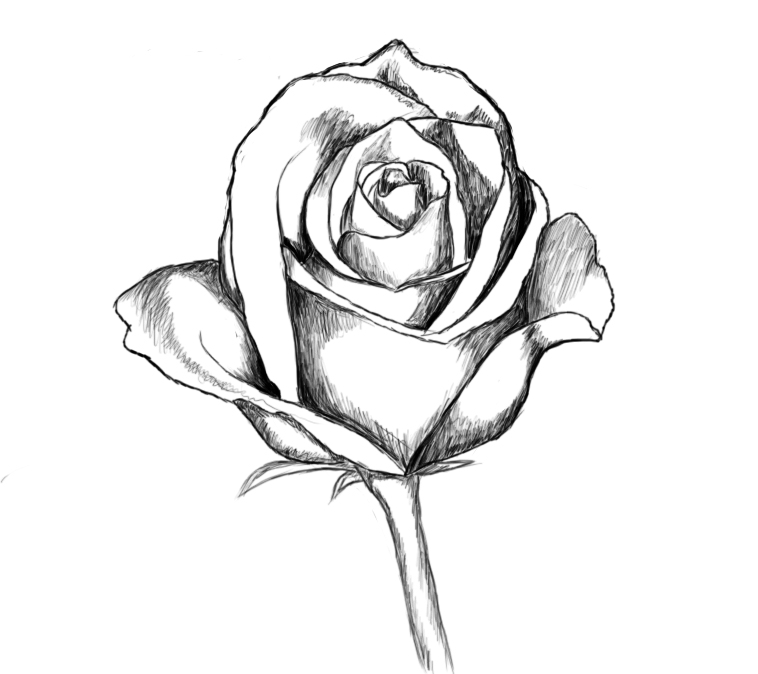Rose drawing is an enchanting skill that allows artists to capture the beauty and intricacy of one of nature's most beloved flowers. Whether you're a beginner looking to explore your creative side or an experienced artist aiming to refine your techniques, this guide will provide you with all the essential information and tips to create stunning rose drawings. In this article, we will delve into the various aspects of rose drawing, including techniques, materials, and inspiration to help you on your artistic journey.
Join us as we explore the intricacies of drawing roses, from basic shapes and shading techniques to advanced methods that will elevate your artwork. With clear instructions and helpful tips, you'll be well on your way to mastering the art of rose drawing.
Table of Contents
- 1. The Significance of Roses in Art
- 2. Essential Materials for Rose Drawing
- 3. Basic Shapes and Proportions
- 4. Step-by-Step Guide to Drawing a Rose
- 5. Shading Techniques for Realism
- 6. Common Mistakes to Avoid
- 7. Finding Inspiration for Your Artwork
- 8. Showcasing Your Rose Drawings
1. The Significance of Roses in Art
Roses have long been a symbol of love, beauty, and passion, making them a popular subject in art throughout history. Artists such as Vincent van Gogh and Georgia O'Keeffe have celebrated the beauty of roses in their works, showcasing the flower's intricate details and vibrant colors. Understanding the cultural significance and historical context of roses can deepen your appreciation for the subject and inspire your own creations.
2. Essential Materials for Rose Drawing
Before diving into the art of rose drawing, it's important to gather the right materials. Here’s a list of essential items you will need:
- Drawing paper (preferably smooth and heavy-weight)
- Pencils (H, HB, and 2B for different shading effects)
- Eraser
- Blending stumps or tortillons
- Colored pencils or watercolor (optional)
Having quality materials can significantly impact the final result of your artwork, so choose wisely!
3. Basic Shapes and Proportions
To create a realistic rose drawing, it's important to start with the basic shapes that form its structure. Here are some tips to help you establish the right proportions:
- Begin with a circle for the center of the rose.
- Add overlapping oval shapes around the circle for the petals.
- Pay attention to the size and placement of the petals to ensure symmetry.
Understanding Petal Shapes
Each petal of a rose has a unique shape, often resembling a teardrop. Observing real roses can help you understand the variations in petal shapes and how they overlap.
4. Step-by-Step Guide to Drawing a Rose
Follow these steps to create your rose drawing:
- Draw the basic outlines using light pencil strokes.
- Refine the shapes and add details to the petals.
- Start shading to create depth and dimension.
- Use blending techniques to smooth out the shading.
- Final touches: darken the edges and add highlights.
Practice each step patiently to develop your skills over time.
5. Shading Techniques for Realism
Shading is crucial for adding realism to your rose drawing. Here are some techniques to consider:
- Use hatching and cross-hatching for texture.
- Apply gradual shading to create depth.
- Experiment with blending stumps for smooth transitions.
6. Common Mistakes to Avoid
As you embark on your rose drawing journey, be mindful of these common pitfalls:
- Overworking the details, which can make the drawing look cluttered.
- Neglecting the background, leaving the rose feeling disconnected.
- Rushing through the shading process.
7. Finding Inspiration for Your Artwork
Inspiration can come from various sources. Consider the following:
- Visit botanical gardens or flower shops for real-life references.
- Browse art books or online galleries featuring rose artworks.
- Join art communities or social media groups to share ideas and gain feedback.
8. Showcasing Your Rose Drawings
Once you've created your masterpiece, it's time to share it with the world! Consider showcasing your work through:
- Art exhibitions or local galleries.
- Online platforms like Instagram or personal art blogs.
- Participating in art competitions.
Conclusion
In conclusion, mastering the art of rose drawing requires practice, patience, and a willingness to learn. By understanding the significance of roses in art, gathering the right materials, and following the techniques outlined in this guide, you can create stunning rose drawings that capture the essence of this beautiful flower. Don't hesitate to explore your creativity, and remember to share your artwork with others!
We invite you to leave a comment below with your thoughts on this guide, share your rose drawings, or ask any questions you may have. Happy drawing!
Penutup
Thank you for reading our comprehensive guide on rose drawing! We hope you found it informative and inspiring. Be sure to return for more art tutorials, tips, and resources to fuel your creativity.


